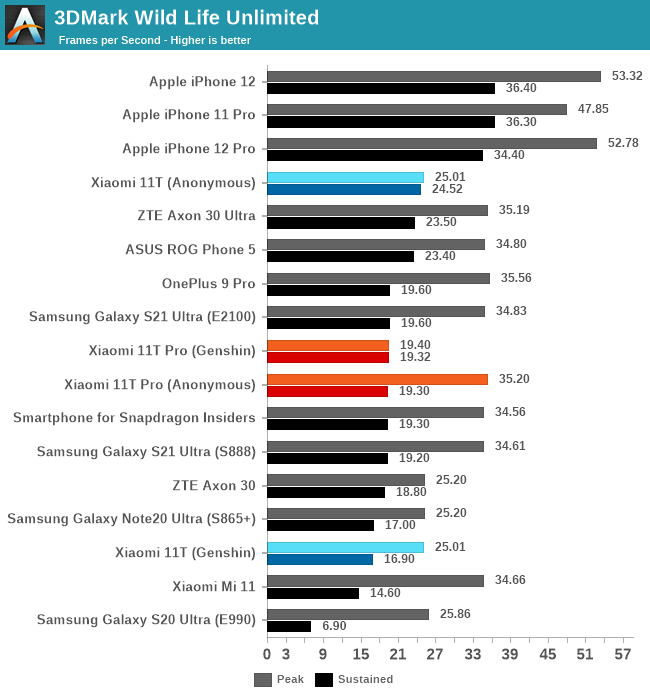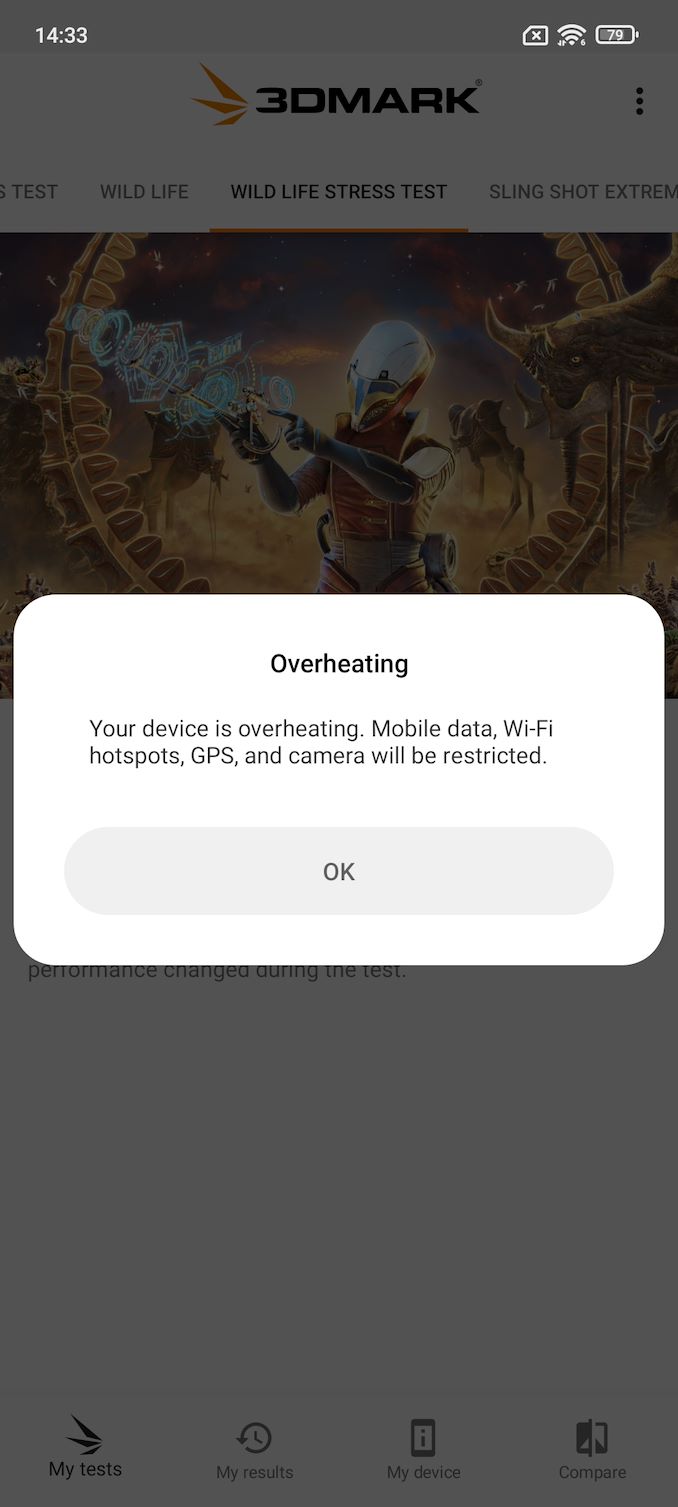The Xiaomi 11T & 11T Pro Review: Two Chips, With a Battery Focus
by Andrei Frumusanu on September 15, 2021 9:00 AM EST- Posted in
- Mobile
- Smartphones
- Xiaomi
- Xiaomi 11T
- Xiaomi 11T Pro
GPU Performance - More "Optimisations"
On the GPU side of things, it’s again a very interesting to match up the Snapdragon 888 versus the Dimensity 1200. The Snapdragon should dominate in peak performance, however sustained is another question.
Unfortunately, the 11T Pro here is again a Snapdragon Xiaomi device like many that we’ve seen in the past – the issue here being is that the phone just outright doesn’t throttle at all. In anonymous applications, the phone will go full power no matter the temperature until at some point it’ll give out an overheating warning.
The MediaTek 11T also didn’t throttle at all, and although the phone reached 47°C at least it didn’t give off any overheating warning.
Lately I’ve been spoofing our workloads as popular games, specifically Genshin Impact, given it’s the most popular and most demanding real world gaming title out there. Benchmarking the game itself is hard because of the dynamic resolution and differing graphics settings depending on devices, but spoofing a standardised workload as the game work well to showcase representative gaming performance.

Unfortunately, this experiment here showcases Xiaomi’s shenanigans:
First off with the MediaTek 11T: the anonymous test doesn’t throttle at all and peak and sustained performance figures are essentially the same, with the chip actually faring quite well here in sustained performance, not accounting for the hot phone.
In the Genshin spoofed test, the device has drastically lower thermal behaviour, and throttles at lot quicker to lower performance states. He phone was generally only 39°C warm which was very good.
On the Snapdragon 11T Pro, there’s quite the shocking revelation; the phone is outright capping peak performance, gutting it to otherwise the sustained performance levels of the anonymous version (before the overheating warning).
Thermals of the phone here are excellent at only around 37°C peak skin temperatures. Generally, the prolonged gaming performance here isn’t changed as the both end up at the same level.
The problem with this “optimisation” is of course that it’s completely misleading the benchmarks. If real games are actually severely limited in GPU frequency and performance, then this should also be represented in benchmarks for transparency.
I’m very exhausted by these opaque mechanisms, because most other reviewers will likely not catch them, which is likely Xiaomi’s goal. It’s a crap industry behaviour that needs to be abolished.
I’m skipping over the rest of the benchmarks here as it’s not even worth showcasing.











41 Comments
View All Comments
zodiacfml - Wednesday, September 15, 2021 - link
not only does 120w charging is crazy, it also appears to charge at a high rate even at 80% battery state. tricks I know is to use two batteries in series and using larger capacity batteries than advertised or lower voltage cutoff. however, those tricks don't appear enough to get up to 120w.yetanotherhuman - Thursday, September 16, 2021 - link
It'd be nice to see some phones again one day, and not just phablets.Linustechtips12 - Thursday, September 16, 2021 - link
very much agreed I will not ever go for an iPhone sorry... but I want the size in between something like the 13 mini and the regular 13 or just a smidge smaller than the s21, the s21 is actually almost perfect coming from an s10e I hope the overall size of the 22 is slightly smaller or the same size as the s10eTheinsanegamerN - Friday, September 17, 2021 - link
So, on a phone like this, how would that work with US carriers? It's not officially sold here, will it work with VoLTE or will these phones be bricks once the 3G networks go down?ATT and verizon are very picky about what is allowed, and while most US sold phones are supported they say nothign about xaiomi.
coolkwc - Sunday, September 19, 2021 - link
If you ever own a fast charging phone and power meter, you will know the 'algorithm' behind the fast charging. The charge current is reduce in staggered, however from what i saw, it is based on temperature capped rather than preset according to SoC. You will noticed that it will reduce the charge in order to keep temperature under 40'C. So if your phone temperature is at the high side when you plug in the charger, the fastest charge rate will not even activated/sustained for any longer, however it will sustain longer if the charge temperature is low. I'm using the Mi 11 Ultra with 67W charger, to preserve the battery life i normally charge using my old QC3.0 samsung charger at home and only charge until 4.3V which is 85-90% full, the sustain charge current is at around 3.5A for the whole charging period. The bundle 67W Xiaomi charger serve as my quick 'travel' charger where i will use when i need a fast top up, which not often based on my use case.Plumplum - Monday, September 20, 2021 - link
Installation of monitoring apps can show problems with CPU behavior...why wasn't it done on the first test?ROM was responsible of the problem.
Problem with Anandtech is how fast they're to accuse Mediatek without asking them questions on how the device and sometime some benchmarks (such as PCMark) behave.
That was already the same with so called cheating.
Unfortunatelly post people won't read the corrected article. The damage is done!
Should made a separate article to apologize!
Premade thought leads to unfair review.
iphonebestgamephone - Saturday, September 25, 2021 - link
Nothing was wrong in cheating one back then. Mediatek not including the cheat mode in dimensity should be enough to tell you all about it.xol - Monday, September 20, 2021 - link
Hot take 1The Cortex X1 is a bad core. Not bulldozer bad but pentium hot/bad/inneficient, which is doubly bad in a mobile environment. ARM added lots of cache and didn't add enough functional units to make it worthwhile. It's half the M1 design - all the cache but lacks the pipeline. bad.
Hot Take 2
Manufacturers (qualcom/xiaomi) know this but can't avoid using latest/"best" core in their latest designs because product spec sheets > actual real world utility.
Hot Take 3
Manufacturers know this too (hot take 2) but still need to use the "bad" X1 cores in their flagships because they need to be "flagship". But the core is crappy and give bad battery life. So they're compensating by essentially disabling as much as they can. (pretty much fact and not hot take)
A ide Hot Take 4
Snapdragon 888 is a "bad" chip too, and not just the X1 core, also the GPU. Quallcomm use the node advantage (5 vs 7nm) to squeeze extra frequency out of their designs, They claim +50% ALU in the new chip (vs 865) but/and clock it at 840 vs 650MHz (+29%). But performance is only +25%. There's real world evidence that the 888 runs hot and thermally throttles in phones way earlier than 865, despite being on 5nm -
sweetca - Tuesday, September 21, 2021 - link
I prefer my spying domestic.Yourdailytask - Thursday, September 23, 2021 - link
hello admingrate post